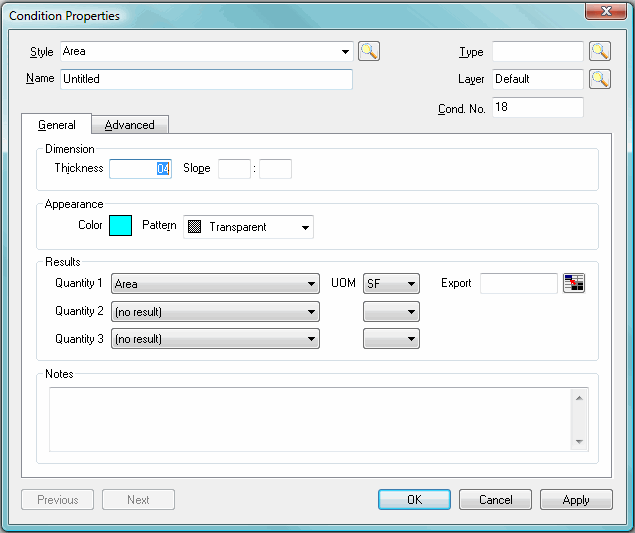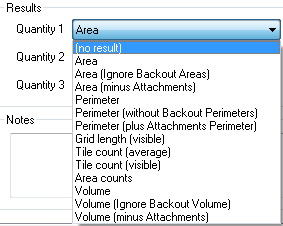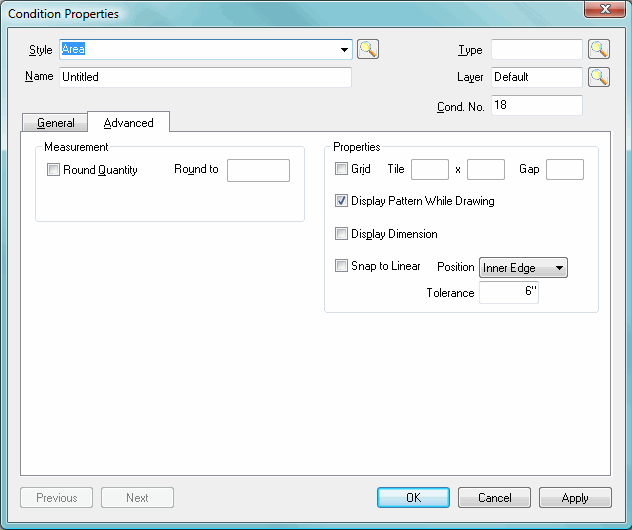Area Condition Properties
Area conditions describe objects such as slabs, ceiling tiles, flooring, roofs and facades that require a measurement for total area. An Area condition can even calculate thickness providing a volume measurement for objects such as slabs.
Area condition - General Tab
The Dimensions area includes optional settings for Thickness and Slope. Appearance sets the Color and Pattern of an object and a field to set the spacing in a non-solid or non-transparent pattern.

|
Area Condition Properties, General Tab | |
|
Thickness |
Thickness allows On-Screen Takeoff to calculate Volume as well as area. Handy for concrete slabs, insulation and bedding. |
|
Slope |
Used primarily for roof takeoffs. On-Screen Takeoff will take into account the Rise:Run or Run:Rise. If performing takeoff on an orthographic project (using a 'birds eye' view) use x:12 for slope (Rise:Run), if taking off an area using an elevation plan, use 12:x (Run:Rise) for slope. Only area and volume are adjusted for slope. Here is a table of different slopes, degrees and grades. |
|
Color |
Sets the color for takeoff performed using the condition. |
|
Pattern |
Sets the pattern for takeoff performed using the condition. |
|
Spacing |
Enter a measurement to set the spacing to be used in non-solid and non-transparent patterns. This only affects how the takeoff is displayed and has no bearing on measurement quantities. |
|
Results |
There are three quantity areas available. See the UOM chart in Section 7 - Databases for more information on measurements.
There are two Area results that are special and depend on the Grid as set on the Advanced tab. These results are also dependent on the way the area is aligned to the Grid. See Aligning an Area condition Grid for more information. |
|
Notes |
This field is for whatever notes to include such as how this condition would be build or any other information that helps identify this condition. |
Area condition Results
Results are the totals for all the measurements taken for a particular condition. Results shown in the Condition window are for the current page only. To see the total for all pages, review the Takeoff or Worksheet tabs. There are several Linear Results options available:

|
Area Quantities |
Definition |
|
Area |
The surface area of an area condition, less the surface area of any backouts but ignoring the area of any attachments. |
|
Area (Ignore Backout Areas) |
The surface area of an area condition, without subtracting Backouts. (For more information on Backouts, see Performing Area Backouts. |
|
Area (Minus Attachments) |
The surface area of an area condition, less the surface area of any attachments. You can setup AttachmentsNOT to back out quantities from their parents if you choose. see Attachment conditions for information. |
|
Perimeter |
|
|
Perimeter (Without Backout Perimeters) |
The linear measurement around the area, not including the perimeter of any Backouts. |
|
Perimeter (Plus Attachment Perimeters) |
The linear measurement around area including the perimeter of any attachments. |
|
Grid Length (Visible) |
|
|
Tile Count (Average) |
|
|
Tile Count (Visible) |
The actual count of tiles adjusted for the grid alignment. Counts each partial or complete tile as one whole tile. |
|
Area Counts |
The count of times an area condition is used, per page. |
|
Volume |
|
|
Volume (Ignore Backout Volume) |
The amount of mass of an area condition ignoring any Backout volumes. |
|
Volume (Minus Attachments) |
The amount of mass of an area condition less the volume of any attachments. You can setup AttachmentsNOT to back out quantities from their parents if you choose. |
Area condition Properties - Advanced Tab
The Area condition Advanced Tab contains options for rounding, using a Grid (tiling) and snapping as well as a couple of display options.
The Measurement field allows you to set a value to round measurements to the nearest whole number increment. This rounds up each SEGMENT of an area condition to the next increment, it does not round up your overall square footage results. For example, if set to 2 feet, each segment of area takeoff is rounded up to the next interval of 2 feet -a line drawn to 10'06" for example, would be calculated as 12'. For example, a square 10'06" would total 122 square feet (with a perimeter of 48 linear feet). It is very important to understand how Rounding works before you begin using this feature as it can dramatically change your takeoff results.
The Properties fields are used to:
- Setup a Grid for quantifying a tiled or bricked area expanse
- Display the conditions Pattern while drawing the takeoff (ON by default, it can be handy to turn this off when takeoff off a large or complicated area)
- Display Dimension - when activated, On-Screen Takeoff will place a small label in the center of each area taken off with this condition showing the individual takeoff objects Quantity 1 result
- Snap to Linear - automatically connects area takeoff to nearby Linear takeoff based on the Position and Tolerance set. See Performing Area Takeoff for more information

|
Area Condition Properties, Advanced Tab | |
|
Round Quantity |
Select the Round Quantity box to apply this feature. |
|
Round to |
Enter a value to the Round to field. Each segment of the condition will be rounded to the nearest increment indicated. For example, if you round to the nearest foot, all takeoff segments for your area, that is-each individual perimeter line- will be rounded to the nearest foot. (if you are drawing a 10' square for example and were rounding to 2', if you are just slightly over on your segments, you could end up with an area quantity of up to 144 sq ft - that's a big difference).
Be careful when rounding, as it can greatly impact on takeoff quantities. |
|
Grid/Tile/Gap |
Check the Grid box then, type in the size of your tiles. Next, enter the gap between each tile. This will create a grid pattern at the specified size for your area takeoff object. The gap setting will control the thickness of the lines for the grid area - just like a acoustical ceiling grid. |
|
Display Pattern While Drawing |
When taking off large or complex areas, it is sometimes easier to suppress the display of the actual pattern while drawing the area. Once the area is 'closed' - it will fill in with the appropriate fill pattern as set on the General Tab. |
|
Display Dimension |
With this box checked, the Quantity 1 result will appear in the center of each area takeoff object that you draw, as in the example below.
If your dimension boxes are too big, you can adjust the Font Size to reduce the size. See Adjusting Annotation Size. |
|
Snap to Linear |
Put a check mark in the Snap to Linear box and then choose a position and tolerance for the area takeoff. This feature will make drawing area takeoffs much easier - the area takeoff will 'snap to' nearby linear condition so it doesn't have to be drawn so precisely. It also makes it easier to auto-fill rectangular rooms. Once a room is already outlined with a linear conditions, double-clicking within that space will auto-fill with the selected area condition. |
|
Position |
Determines where the perimeter segments of area takeoff will locate themselves in relation to the nearest parallel linear object.
|
|
Tolerance |
Set for the distance that the snap to linear feature uses to snap the area takeoff to the linear takeoff. For example, if set to 1' 6", then when area takeoff is drawn within 1' 6" of a linear takeoff object, the area would automatically to the linear takeoff. |







